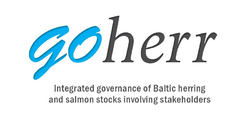Goherr performance statistics
From Opasnet
Contents
Question
How has the Goherr project preformed based on the indicators set by the funders?
Answer
| Indicator | UH | THL | SLU | UOUL | IFM-AAU |
|---|---|---|---|---|---|
| N of times: contributions to develpment/implementation of regulations, policies, management practices on internationa, European, the Baltic Sea region or national level aimed at safeguarding the sustainable use of ecosystem's goods and services, in particular the EU Strategy for the Baltic Sea Region, EU Integrated MaritimePolicy, EU Marine Strategy Framework Directive (MSFD) and its implementation, as well as the Baltic Sea Action Plan. (provide more information in periodic and final reports) | |||||
| N of suggestions for designing, implemeting, evaluating the efficacy of relevant public policies and governance on International, European, the Baltic Sea Regiona or national level originating from the work of the project (provide more information in periodic and final reports) | |||||
| N of times the scientists have served as members or observers in stakeholder committees (EC, Helcom, Vasab, ICES etc). (provide more info in periodic and final reports) | |||||
| N of international, national, regional stakeholder events organised by the project (provide info about the number of participants and kinds of sectors represented in the periodic and final reports) | |||||
| N of joint events/co-operation activities/parnterships of the project with non-Baltic research actors and other European marine basins (provide more info in periodic and final reports) | |||||
| N of persons and working days spent by foreign scientists on research vessels participating in the cruises arranged by the project | |||||
| N of persons and working days spent by foreign scientists using other major research facilities involved in the project | |||||
| N of peer-reviewed publications arising from the project research with authors from, at least, two different participating states | |||||
| N of entries to existing openly accessible common databases, storing original data from the entire Baltic Sea system or larger geographical area. | |||||
| N of popular science papers produced by the project | 1 | ||||
| N of interviews to media given by the members of the project's consortium | |||||
| N ofmulti-media products and TV episodes produced by the project with dissemination purpose | |||||
| N of other international, national and regional communication, dissemination and public outreach initiatives to disseminate the project's research results | |||||
| N of post graduate courses organised by the project and persons participating. | |||||
| N of mobility activities (persons, visit days) from the project to the other BONUS projects | |||||
| N of PhD students and the number of post-docs funded by the project as well as the number of doctoral thesis defended | 1 | 1 | 1 | ||
| Table of distribution of the project's research staff involved (fully or partly funded or contributed as in kind) by age class (<25, 25-49, 50-64, >64), seniority (PhD students, post-docs, assistants, lecturers, instructors and equivalent; associate professors and equivalent; and full professors and equivalent ) and gender. | |||||
| List of other significant kind, free of charge research infrastructures used by the project for which no bilateral agreements between the infrastructura provider(s) and BONUS have been concluded (required data: description / type of used infrastructure and metrics charaterising the amount of use, and approx. monetary estimate of the in kind contributions). | |||||
| List of other than infrastructure in kind contributions the project has received (required data: type of in kind contribution and metrics characterising the received amount, and approximate monetary estimate of the in kind contribution) |
Rationale
The table is based on statistics reported by the partners themselves.



